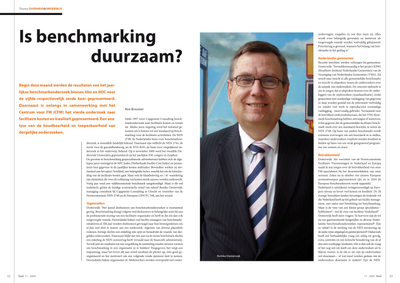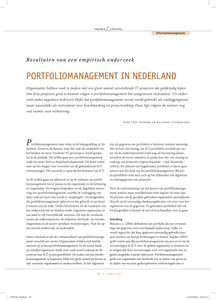Begin deze maand werden de resultaten van het jaarlijkse benchmarkonderzoek binnen hbo en ROC voor de vijfde respectievelijk zesde keer gepresenteerd. Daarnaast is onlangs in samenwerking met het Centrum voor FM (CFM) het vierde onderzoek naar facilitaire kosten en kwaliteit gepresenteerd. Een analyse van de houdbaarheid en toepasbaarheid van dergelijke onderzoeken.
DOCUMENT

While the original definition of replacement focuses on the replacement of the use of animals in science, a more contemporary definition focuses on accelerating the development and use of predictive and robust models, based on the latest science and technologies, to address scientific questions without the use of animals. The transition to animal free innovation is on the political agenda in and outside the European Union. The Beyond Animal Testing Index (BATI) is a benchmarking instrument designed to provide insight into the activities and contributions of research institutes to the transition to animal free innovation. The BATI allows participating organizations to learn from each other and stimulates continuous improvement. The BATI was modelled after the Access to Medicine Index, which benchmarks pharmaceutical companies on their efforts to make medicines widely available in developing countries. A prototype of the BATI was field-tested with three Dutch academic medical centers and two universities in 2020-2021. The field test demonstrated the usability and effectiveness of the BATI as a benchmarking tool. Analyses were performed across five different domains. The participating institutes concluded that the BATI served as an internal as well as an external stimulus to share, learn, and improve institutional strategies towards the transition to animal free innovation. The BATI also identified gaps in the development and implementation of 3R technologies. Hence, the BATI might be a suitable instrument for monitoring the effectiveness of policies. BATI version 1.0 is ready to be used for benchmarking at a larger scale.
DOCUMENT

The rapidly evolving aviation environment, driven by the Fourth Industrial Revolution, encompasses smart operations, communication technology, and automation. Airports are increasingly developing new autonomous innovation strategies to meet sustainability goals and address future challenges, such as shifting labor markets, working conditions, and digitalization (ACI World, 2019). This paper explores high-level governance strategies, a benchmarking study, that facilitates this transition. It aims to identify the key characteristics and features of the benchmarking study applicable to the development of autonomous airside operations. It also examines areas for improvement in operations, focusing on Key Performance Areas (KPAs) and strategic objectives related to airside automation. The findings highlight several essential performance areas and formulate it to a tailored benchmarking study that airports or aviation stakeholders can adopt to develop automation in airside operations. These criteria and features are summarized into a benchmarking framework that reflects strategy objectives. This paper contributes a valuable benchmarking methodology, supporting the growing global aviation demand for improvements toward more sustainable and smart autonomous airside operations. This outcome motivates aviation stakeholders to innovate to meet environmental and social sustainability goals.
DOCUMENT

The remarkable and continuous growth of the unmanned aircraft market has brought new safety related challenges, as those are recorded in various accident and incident reports. Although drones with an operating weight higher than 20-25Kgs are technologically advanced and often subject to standards (e.g., technical reliability, airspace management, licensing, certification), the regulatory framework for (ultra) light drones focuses almost exclusively on the limitations that the operator needs to consider. Thus, the protection from accidents seems to rely mostly on the competency of the operator to fly a drone safely, and his/her observance of the rules published by the respective authorities. In addition, the hazards lying in the interaction between an operator and a small drone have not been systematically studied. In this paper, we present (1) the first results from a System-Theoretic Process Analysis (STPA) based approach to the identification of hazards and safety requirements in small drone operations, and (2) an adaptation of the Risk Situation Awareness Provision Capability (RiskSOAP) methodology in order to quantify the differences amongst 4 drone models regarding the extent to which they fulfill the safety requirements identified through STPA. The results showed that the drones studied satisfy the safety requirements at low and moderate levels and they present high dissimilarities between them regarding the extent to which they meet the same safety requirements. Future work will include: (a) comparison of a larger sample of small drones against the safety requirements, as well as pairwise, and (b) assessment of the degree to which various regulatory frameworks worldwide address the safety requirements generated with STPA and assigned to the authority level.
DOCUMENT

Sinds 1 januari 2013 moeten bedrijven — of hun accountants, administratiekantoren of belastingadviseurs — de aangifte VPB en IB-winst indienen via een nieuwe elektronische standaard: Standard Business Reporting (SBR).In deze bijdrage wordt het belang van deze procesinnovatie besproken in het licht van het gebruik van gegevens uit SBR-berichten, zoals die voor de aangifte VPB en IB-winst, voor benchmarking en het beoordelen van MKB-kredietwaardigheid.
LINK
Since 2012 the dutch metropolitan area (the metropole region of amsterdam, the city of amsterdam, rotterdam, the hague, utrecht ) cooperate in finding the best way to stimulate electric mobility through the implementation of a public charging infrastructure. with more than 5600 charge points and 1.6 million charge sessions in the last two years this is one of the most extensively used public charging infrastructure available worldwide. in this paper a benchmark study is carried out to identify different charge patterns between these 5 leading areas with an extensive public charging infrastructure to establish whether and how charge behaviour (e.g. charged volume, capacity utilization, unique users) differs between cities. based on the results first explanations for possible differences in charge patterns between cities will be provided. the study aims to contribute to a better understanding of the utilization of public charging infrastructure in a metropolitan area existing of four city centres and the amsterdam metropolitan area and to provide input for policy makers to prepare a public charging infrastructure ready for the projected growth of electric mobility in the next five years.
DOCUMENT

Organisaties hebben vaak te maken met een groot aantal verschillende IT-projecten die gelijktijdig lopen. Om deze projecten goed te kunnen volgen is portfoliomanagement het aangewezen instrument. Uit onderzoek onder negentien bedrijven blijkt dat portfoliomanagement vooral wordt gebruikt als vastleggingstool, maar nauwelijks als instrument voor benchmarking en projectranking. Daar ligt volgens de auteurs nog veel ruimte voor verbetering.
DOCUMENT
